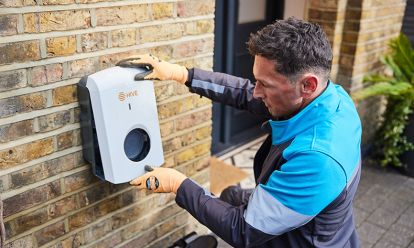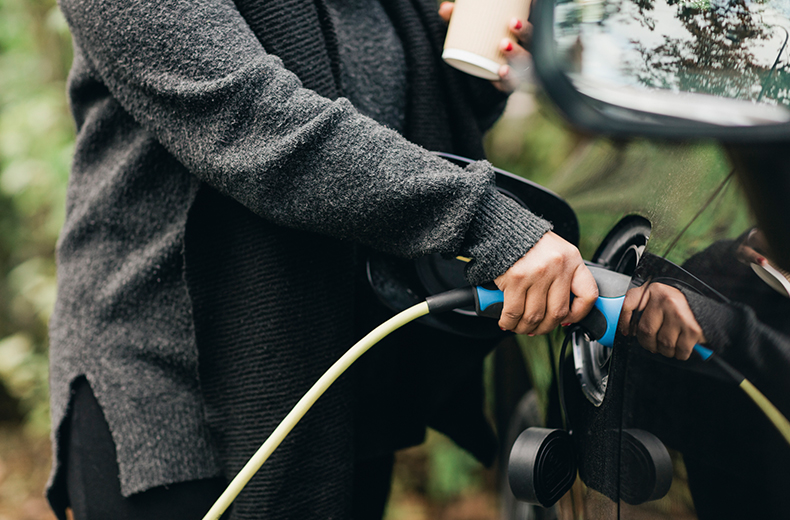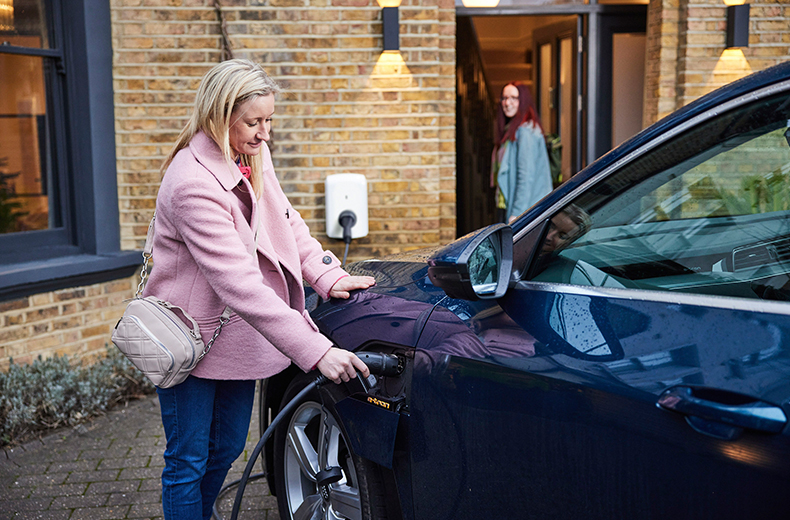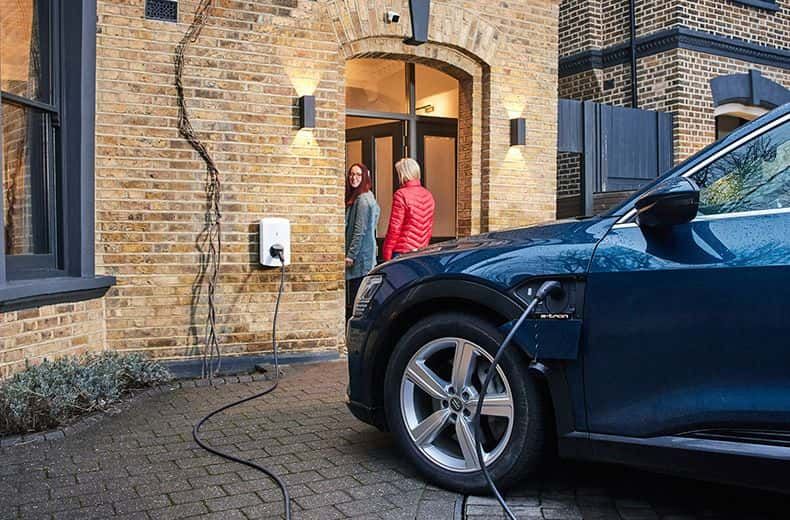Saying goodbye to petrol stations is a key benefit of EV ownership, but you could also minimise the number of times you visit a public charging station. Simply arrive home in your EV, plug it in and wake up to a fully charged battery in the morning.
Using a home charger is the cheapest, most convenient and safest way to charge an Electric Vehicle (EV), which is why it’s the default choice for EV owners that have access to off-street parking or kerbside charging solutions.
Here’s everything you need to know about charging your electric car at home.
How to charge an electric car at home
There are two options for charging an electric car at home: using a domestic three-pin socket or a dedicated EV charge point.
Charging with a domestic socket should be reserved for emergency or occasional use; it's fine for an overnight charge when visiting friends or relatives, but not ideal for regular use at home.
By all means keep a standard 3-pin UK plug-compatible charging cable in the boot, but installing a home charger (or wallbox) is the recommended solution.
A dedicated home charge point will communicate with the electric car's on-board electronics, making it the safest method of domestic charging.
A smart home charger will also allow you to take advantage of cheaper energy tariffs, charging the EV when supply is high but demand is low. For up-to-date pricing, visit RAC Charge Watch.
You'll also need to work out what speed your home charger can deliver. Most homes have a single-phase electricity supply, limiting how much charge can be supplied by a home wallbox to 7kW.
Some home will have access to three-phase electricity, meaning 11kW or 22kW AC charging is possible (as long as your EV will accept that much). This will charge your car much more quickly.
Install a home charging point
Going electric? Installing a home charging point makes owning an electric car so much easier and cheaper.


Tethered or untethered home charge point?
Having chosen whether to opt for a 3.6kW, 7kW or 22kW charger, you must also decide whether you want a tethered or untethered charge point. It all comes down to personal preference, but there are a few things you need to consider.
The difference is quite simple: a tethered charger has a cable attached, while an untethered unit doesn’t.
A tethered charger will come with a cable for a Type 2 socket, so you don’t need to carry a cable in the boot of your EV.
While that’s convenient, you could be left with an obsolete home charge point should the industry eventually move away from Type 2 sockets (unlikely, but possible). You also have to put up with a fixed cable length and the need to tidy it away when not in use.
An untethered charger looks tidier, but you’ll have to supply your own cable. Most EVs will come with a cable included in the purchase price, but you’ll spend around £100 for a replacement.
On the plus side, an untethered charger gives you more flexibility; you won’t have to change the unit should you buy an EV with a different plug requirement.
- Electric car charging – how it works and how much it costs
- How long does it take to charge an electric car? Charging speeds explained
- Electric car leasing explained – EV financing vs buying
How to get a home charger installed

Some car manufacturers offer free or discounted home chargers when you buy a new EV or lease an EV. But look closely at these bundles because they may not be right for you, or even a good deal at all.
Where to put a home charge point
Here are some things to consider when you’re choosing a place for your charge point.
- Do you want the charge point to be hidden or on view? Whether you have a tethered or untethered charge point will make a difference here, you may not want the tethered cable to look like a coiled garden hose on the front of your house
- Where is the charging port on your EV? Some are easy enough - right on the front, but others are on a side, or even further back where you’d normally have a fuel filler cap
- Factor in the length of the charging cable. Even on a private drive, a cable can present a very serious trip hazard
- The charger will also require access to your home wifi signal to take advantage of the smart tools, such as remote charging and access to off-peak energy tariffs, so mounting it at the furthest corner from your router may not be ideal
What speed do I need for a home charge point?
To fully recharge a Kia EV6 with a 77kWh battery, the slowest and cheapest home charger with a rate of 3.6kW will take almost 24 hours. This makes it only really practical for overnight charging on smaller EVs.
A 7kW home charger will be twice as fast as a domestic socket, delivering around 22 miles of electric range per hour. This makes it ideal for EVs with any size battery, and needing charge at any time of day.
A 22kW home charger will be even faster, but this requires a three-phase electricity supply, making it unsuitable for the vast majority of EV owners.
Some homeowners upgrade to a three-phase electricity supply when they convert a house into flats, extend a property or install high-power equipment, such as an air-source heat pump. In theory, these homes should deliver faster charging times.
However, many EVs are actually unable to even accept a 22kW charge, so you should check the handbook or consult your nearest dealer before upgrading your home. Costs vary, but you’re looking at anything between £3,000 and £20,000 for a three-phase supply.
A single-phase supply will have a single fuse, while a three-phase electricity supply will have a trio of 100 amp fuses.
The cost of electric car charging at home

To get the most up-to-date pricing, click here.
- How much does it cost to charge an electric car?
- Electric vehicle range – how far can I drive in an EV?
- Cheapest electric cars – best used and new EVs in 2023

RAC sale – up to 33% off*
• Roadside cover from £5.29 a month†
• We get to most breakdowns in 60 mins or less
• Our patrols fix 4/5 breakdowns on the spot

Save money on charging an electric car at home
EV energy tariffs
Your home energy bills will increase with an EV plugged into the mains. However, this needn’t mean that your household bills will rocket. Citizens Advice says it's worth considering if a fixed-rate electricity tariff works for you
A smart home charging point like ours will automatically select the cheapest time to charge your electric car. Off-peak electricity can be supplied from as little as 7p per kWh - much cheaper than the current 24.5p per kWh price cap.
Rates differ depending on your postcode, but EV energy tariffs live these have been devised with electric car owners in mind, so they’re usually the best option for EV drivers’ needs.
Vehicle-to-grid charging
Although it’s currently only available to business customers, vehicle-to-grid (V2G) charging allows you to ‘sell’ electricity to the National Grid. When a number of EVs are connected to the network, they can discharge electricity to the network when it’s needed most.
Pre-cooling and pre-heating
A side benefit of home charging is the ability to pre-cool or preheat the car’s cabin before a journey. This can usually be done via a smartphone app linked to the car.
Because the energy is drawn from the mains supply rather than the battery, there’s no impact on the estimated driving range. You won’t even have to wait for the windows to demist on a cold morning!
Conclusion
Home charging is the straightforward, sensible and affordable way to charge your electric car. You decide when to charge and, to a certain extent, how much to pay for the electricity.
With a little forward planning, such as choosing the right charge point and energy tariff, you can enjoy the full benefits of charging at home.
For more information, check out our guide to the cost of electric car charging.
Install a home charging point
Going electric? Installing a home charging point makes owning an electric car so much easier and cheaper.















